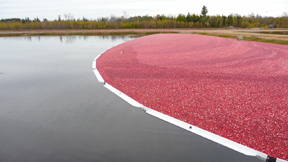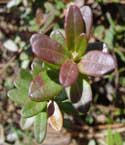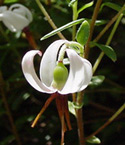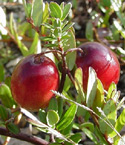Bulletin #2247, Commercial Cranberry Production in Maine: An Introduction

Bulletin #2247, Commercial Cranberry Production in Maine: An Introduction (PDF)
Developed by David T. Handley, Extension Small Fruit and Vegetable Specialist. Updated by Charles Armstrong, Extension Cranberry Professional, 2003.
For information about UMaine Extension programs and resources, visit extension.umaine.edu.
Find more of our publications and books at extension.umaine.edu/publications/.
Table of Contents:
- The Cranberry Plant
- Environmental Concerns and Regulations
- Site Selection and Preparation
- Planting and Management
- Pest Management
- Costs and Returns
- Marketing
- Summary
- For More Information
- Suggested Reading
The cranberry industry, after having recently weathered some of the worst years in its history, is now once again heading in a positive direction. Nationwide, from 1999 to 2001, prices for cranberries destined for processing reached rock-bottom levels that were far below production costs. A surplus of frozen cranberries may have been the culprit.
Industry leaders have developed new and popular cranberry products with strategic advertising campaigns, and have focused on the health benefits of cranberry consumption. Such efforts are beginning to pay off. The price for processed fruit is now expected to continue upwards and arrive at a modest but profitable and stable level.
The Cranberry Plant
The cranberry (Vaccinium macrocarpon) is native to the swamps and bogs of northeastern North America. The plant is a low-growing, woody perennial with small, oval leaves borne on fine, vine-like shoots. Horizontal stems, or runners, grow along the soil surface, rooting at intervals to form a dense mat. Flower buds, formed on short, upright shoots, open from May to June and produce ripe fruit in late September.
Environmental Concerns and Regulations
A small but viable cranberry industry existed in Maine during the latter half of the 19th century. Bogs were typically established by modifying what was then considered suitable sites: preexisting bogs and wetlands. Today, such sites are protected by federal, state and local laws designed to preserve valuable water resources and wildlife habitats. Therefore, any new cranberry plantings which would use such sites must meet strict performance standards to minimize environmental impacts and must be approved by federal and state regulatory agencies, including the U.S. Army Corps of Engineers, the Maine Department of Environmental Protection and local review boards. These agencies may conditionally approve the construction of cranberry plantations in some wetlands. However, developing an application to modify a wetland will require the expertise of a lawyer and engineer. This will be quite costly and does not guarantee the success of the application.
Environmental Considerations:
- Wetland sites are protected by federal, state and local laws to preserve water resources and wildlife habitats.
- Wetland sites must meet strict standards that are set by federal and state regulatory agencies.
- Establishing upland sites generally requires the construction of costly water sources.
Site Selection Considerations:
- A good site should be relatively isolated and include a natural vegetative buffer zone.
- Site should have a gentle slope and be somewhat elevated.
- Subsoil should be clay or silty clay type. Surface soils should be sandy or organic in nature.
- Suitable space is necessary for building a reservoir.
Cranberries can also be established on dry, upland sites, as the vast majority of Maine’s cranberries are today. This method requires the establishment of contained water sources, including ponds, bogs, and dikes. The construction and operation of such facilities is expensive. Existing wetlands in the area should not be disturbed unless appropriate permits have been obtained. Again, approval must be given by various agencies before construction can begin.
Site Selection and Preparation
A good site for an upland cranberry plantation should be relatively isolated, with a natural vegetative buffer zone protecting any water sources. The land should have a gentle slope and be somewhat elevated to ease water management. The subsoil should be of clay or silty clay type. Surface soils should be sandy or organic in nature. A supply of water for flooding and irrigation must be relatively easy to develop and should be capable of flooding the bogs to a two-foot depth. There should also be space suitable for building a reservoir below the bogs to hold runoff water and catch any pesticides it may carry. There should be an ample source of clean, coarse sand nearby. Finally, the land should be reasonably priced for agricultural use.
A suitable site must be carefully surveyed to properly design a water management system. The land is cleared and “scalped” of its surface vegetation. Reservoirs are dug and a system of ditches and dikes are constructed to control flooding and draining of the bogs. A plantation typically has a series of beds, each roughly one to two acres in size, to best manage water and harvesting.
Planting and Management
Cranberry cuttings are planted in May, following an application of sand two to four inches deep over the beds. The six- to ten-inch-long cuttings are planted by hand at about nine-inch intervals over the bed. They may also be spread over the bed and pressed into the sand by machine. With proper care, the cuttings will root and grow and should nearly cover the bed by the end of two seasons.
Once established, the beds are flooded every year in the late fall to protect the cranberry plants from winter winds and sub-zero temperatures, and to help control over-wintering insect pests. The beds are drained in the spring, and fertilizers are applied.
Irrigation should be applied on cold nights to protect the flowers from frost. Colonies of bees should be placed around the bogs during bloom to improve pollination and increase fruit set. The plants need irrigation throughout the summer. Typically, when the fruits ripen in the fall, the bogs are flooded and beating machines are driven over the plants to dislodge the fruit. The fruit floats to the surface and is pushed to a corner of the bog to be loaded into trucks or crates.
Cranberries can also be “dry-harvested” using rakes or mechanical pickers. Yields tend to be lower when fruit is dry-harvested, and more labor is required, but such fruit are usually sold for fresh market and bring a significantly higher price. Most cranberries nationwide are sold for processing into products, such as juice and sauce. Well-managed bogs should produce 100 to 200 barrels of cranberries per acre, each barrel weighing 100 pounds. Maine’s average yield for 2002 was only 93 barrels per acre, but this figure has been rising each year as the state’s younger plantings mature. In 1999, just after several new plantings were harvested for the first time, the average yield was just 24 barrels per acre.



Pest Management
Various insects and diseases attack cranberries during the growing season and can ruin the crop. These have traditionally been controlled by insecticide and fungicide sprays. Weeds are also a critical concern and are managed primarily through a combination of herbicides and hand-weeding. Overall pesticide use in cranberries is declining as many growers can no longer afford the high costs involved. Furthermore, many new organic control practices are making their way into current integrated pest management (IPM) recommendations. The responsible use of pesticides, combined with modern IPM techniques, should minimize risk to the environment or public health.
Interest in growing cranberries in Maine organically (without any synthetic fertilizers or pesticides) is on the rise. The unique management system and pest complex of cranberries make this challenging, particularly for plantations greater than two or three acres. However, due to recent and ever-increasing advances in research-based organic pest control practices, crop losses are declining, particularly those caused by cranberry fruitworm. Furthermore, given the high premium being paid for organic cranberries, and the surge taking place nationwide for organic foods in general, it is easy to understand why more and more growers are transitioning part or all of their acreages to organic operations.
Costs and Returns
The estimated cost of constructing an upland cranberry plantation in Maine and bringing it into commercial production (a four-year period) can range anywhere from $20,000 to just over $50,000 per acre. Maine growers feel the average is probably around $35,000 per acre, as many of them owned some of the necessary construction equipment beforehand, but costs vary greatly since peoples’ start-up needs vary. The bulk of the expenses are divided among land, clearing, excavation, equipment, sand, and plants. Costs are affected by what an individual already owns, and what he or she can get done without paid assistance. Annual expenses include fuel, fertilizers, pesticides, bee rentals, equipment maintenance and repairs, ditches and dikes, as well as labor throughout the growing and harvest seasons. If approval can be gained from federal, state and local agencies to construct bogs on marginal wetlands, establishment costs can be greatly reduced. If all goes well, a newly constructed acre should pay for itself after an average of 12 years (six to nine years for successful organic plantations) and generate an annual return of somewhere between $4,500 and $8,250 for processed berries, assuming a yield of 150 barrels per acre and a somewhat conservative price of $30 to $55 per barrel. Returns would probably be two to three times higher for growers selling dry-harvested or organic berries. New growers need to realize, however, that it takes several years and very good management practices to reach the 150 barrels per acre mark, which is the average for Massachusetts growers. In 2002, Maine growers’ yields ranged anywhere from a low of just 10 barrels per acre to a high of 146 barrels per acre (some individual bogs have surpassed 200 barrels per acre on a few occasions). Yields on organic bogs have been at 50 barrels per acre, but are expected to increase because of recent advances in organic pest control.
Marketing
It is critical that a marketing plan is developed before construction of the plantation begins, and that all marketing options be considered. Talk to some current growers about their markets (many are willing to share their secrets), and take advantage of the Internet and Web sites to familiarize yourself with the marketing side of the industry. Two Maine blueberry processors, Jasper Wyman & Son, Inc. and Cherryfield Foods, Inc., have been buying up most of the cranberries harvested in Maine. Wyman’s was not able to buy all that it wanted from Maine growers in 2001 and had to go outside the state to meet its needs, demonstrating the lack of any surplus of cranberries in Maine. In fact, from the very beginning of Maine’s ‘reborn’ cranberry industry (which began in 1989), local markets for fresh cranberries within the state have been strong, and growers have had an easy time finding niche markets here for their berries or value-added cranberry products. In addition, fresh Maine cranberries can now be found during October and November in most Shaw’s and Hannaford supermarkets throughout the state. Some of the smaller and more regional stores, such as IGA, have also been eager to buy Maine cranberries, and growers report selling double the amount of bags compared to the lower-priced Ocean Spray® brand berries, further suggesting that in-state demand for Maine cranberries is strong.
Summary
- Although there has yet to be a surplus of cranberries in Maine, an overall national surplus from 1999 to 2001 of cranberries destined for processing (i.e. water-harvested fruit) caused a price collapse that, even in Maine, resulted in prices that were far below production costs. However, due to aggressive development and promotion of new cranberry products (particularly by Ocean Spray®), and additional positive health findings, prices are rebounding and are expected to incrementally increase, eventually arriving at a modest but profitable level that is less subject to large fluctuations.
- Construction of a new cranberry plantation is most likely to win approval on an upland site because suitable wetlands are protected by federal, state and local laws. Site permits must be obtained from the appropriate agencies before construction can begin.
- The costs of establishing a cranberry plantation are very high for an agricultural commodity — generally between $20,000 and $50,000 per acre. A newly constructed acre should generate an annual return of somewhere between $4,500 and $8,250 for processed berries, assuming a yield of 150 barrels per acre and a somewhat conservative price from $30 to $55 per barrel. Returns for dry-harvested or organic berries are likely to be two to three times higher.
- Water management (flooding and irrigation), weed, insect and disease control, bee rental, fertilization, harvesting, labor recruitment and supervision, equipment maintenance and marketing are major concerns that need to be addressed every season.
- Local markets for fresh cranberries in Maine have been consistently strong, and so growers using dry-harvesting methods have had an easy time finding profitable niche markets for their berries and value-added cranberry products. This has been especially true for Maine’s handful of organic cranberry growers.
For More Information
Contact your University of Maine Cooperative Extension County Office or visit our Cooperative Extension: Cranberries website.
Suggested Reading
Carolyn DeMoronville, Establishing and Upland Cranberry Bed in Maine (University of Massachusetts, 1995 workshop). Adapted by David Yarborough 1996, revised by Charles Armstrong 2002 (the University of Maine).
Charles Armstrong, et al., Cranberry Production Timeline (Cherryfield, ME: Down East RC&D, 1996). Revised 2002 (the University of Maine).
Planting New Cranberry Beds: Recommendations and Management (University of Massachusetts Cranberry Experiment Station 2001).
Best Management Practices for Massachusetts Cranberry Production, Year 2000 Update (UMass Extension in cooperation with Massachusetts Department of Food and Agriculture).
Cranberries magazine (Rochester, MA). $25 per year or $50 for two years.
Paul Eck, The American Cranberry (New Brunswick, NJ: Rutgers University Press, 1990).
Information in this publication is provided purely for educational purposes. No responsibility is assumed for any problems associated with the use of products or services mentioned. No endorsement of products or companies is intended, nor is criticism of unnamed products or companies implied.
© 2004
Call 800.287.0274 (in Maine), or 207.581.3188, for information on publications and program offerings from University of Maine Cooperative Extension, or visit extension.umaine.edu.
In complying with the letter and spirit of applicable laws and pursuing its own goals of diversity, the University of Maine System does not discriminate on the grounds of race, color, religion, sex, sexual orientation, transgender status, gender, gender identity or expression, ethnicity, national origin, citizenship status, familial status, ancestry, age, disability physical or mental, genetic information, or veterans or military status in employment, education, and all other programs and activities. The University provides reasonable accommodations to qualified individuals with disabilities upon request. The following person has been designated to handle inquiries regarding non-discrimination policies: Director of Equal Opportunity and Title IX Services, 5713 Chadbourne Hall, Room 412, University of Maine, Orono, ME 04469-5713, 207.581.1226, TTY 711 (Maine Relay System).

